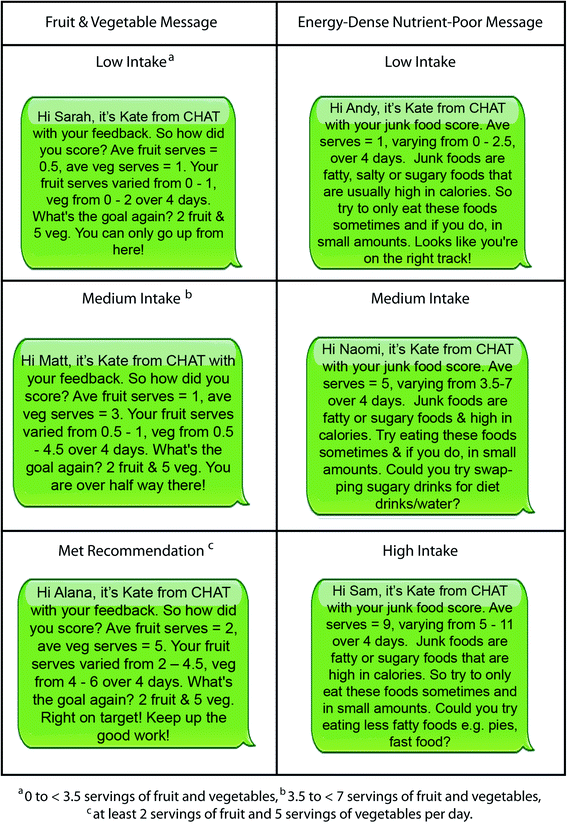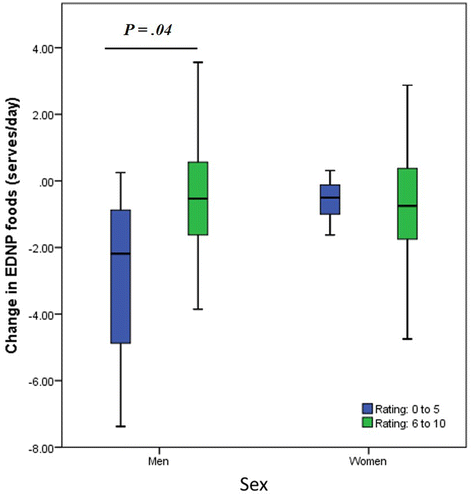The connecting health and technology study: a 6-month randomized controlled trial to improve nutrition behaviours using a mobile food record and text messaging support in young adults
- PMID: 27098449
- PMCID: PMC4839101
- DOI: 10.1186/s12966-016-0376-8
The connecting health and technology study: a 6-month randomized controlled trial to improve nutrition behaviours using a mobile food record and text messaging support in young adults
Abstract
Background: Early adulthood represents the transition to independent living which is a period when changes in diet and body weight are likely to occur. This presents an ideal time for health interventions to reduce the effect of health problems and risk factors for chronic disease in later life. As young adults are high users of mobile devices, interventions that use this technology may improve engagement. The Connecting Health and Technology study aimed to evaluate the effectiveness of tailored dietary feedback and weekly text messaging to improve dietary intake of fruit, vegetables and junk food over 6 months among a population-based sample of men and women (aged 18-30 years).
Methods: A three-arm, parallel, randomized control trial was conducted. After baseline assessments, participants were randomized to one of three groups: A) dietary feedback and weekly text messages, B) dietary feedback only or C) control group. Dietary intake was assessed using a mobile food record App (mFR) where participants captured images of foods and beverages consumed over 4-days at baseline and post-intervention. The primary outcomes were changes in serves of fruits, vegetables, energy-dense nutrient-poor (EDNP) foods and sugar-sweetened beverages (SSB). The intervention effects were assessed using linear mixed effect models for change in food group serves.
Results: Young adults (n = 247) were randomized to group A (n = 82), group B (n = 83), or group C (n = 82). Overall, no changes in food group serves for either intervention groups were observed. An unanticipated outcome was a mean weight reduction of 1.7 kg (P = .02) among the dietary feedback only. Men who received dietary feedback only, significantly reduced their serves of EDNP foods by a mean of 1.4 serves/day (P = .02). Women who received dietary feedback only significantly reduced their intake of SSB (P = .04) by an average of 0.2 serves/day compared with controls.
Conclusions: Tailored dietary feedback only resulted in a decrease in EDNP foods in men and SSB in women, together with a reduction in body weight. Using a mobile food record for dietary assessment and tailored feedback has great potential for future health promotion interventions targeting diet and weight in young adults.
Trial registration: Australian Clinical Trials Registry Registration number: ACTRN12612000250831 .
Keywords: Dietary assessment; Energy-dense nutrient poor foods; Fruit; Interventions; Junk food; Mobile food record; Novel technology; Sugar-sweetened beverages; Tailoring; Text messaging; Vegetables; Young adult.
Figures




Similar articles
-
Connecting Health and Technology (CHAT): protocol of a randomized controlled trial to improve nutrition behaviours using mobile devices and tailored text messaging in young adults.BMC Public Health. 2012 Jun 22;12:477. doi: 10.1186/1471-2458-12-477. BMC Public Health. 2012. PMID: 22726532 Free PMC article. Clinical Trial.
-
Image-Based Dietary Assessment and Tailored Feedback Using Mobile Technology: Mediating Behavior Change in Young Adults.Nutrients. 2019 Feb 19;11(2):435. doi: 10.3390/nu11020435. Nutrients. 2019. PMID: 30791502 Free PMC article.
-
Perception v. actual intakes of junk food and sugar-sweetened beverages in Australian young adults: assessed using the mobile food record.Public Health Nutr. 2017 Sep;20(13):2300-2307. doi: 10.1017/S1368980017000702. Epub 2017 Jun 5. Public Health Nutr. 2017. PMID: 28578736 Free PMC article.
-
Discrete strategies to reduce intake of discretionary food choices: a scoping review.Int J Behav Nutr Phys Act. 2016 May 6;13:57. doi: 10.1186/s12966-016-0380-z. Int J Behav Nutr Phys Act. 2016. PMID: 27151280 Free PMC article.
-
New mobile methods for dietary assessment: review of image-assisted and image-based dietary assessment methods.Proc Nutr Soc. 2017 Aug;76(3):283-294. doi: 10.1017/S0029665116002913. Epub 2016 Dec 12. Proc Nutr Soc. 2017. PMID: 27938425 Review.
Cited by
-
A Survey on Automated Food Monitoring and Dietary Management Systems.J Health Med Inform. 2017;8(3):272. doi: 10.4172/2157-7420.1000272. Epub 2017 Jul 15. J Health Med Inform. 2017. PMID: 30101038 Free PMC article.
-
BMI is Associated with the Willingness to Record Diet with a Mobile Food Record among Adults Participating in Dietary Interventions.Nutrients. 2017 Mar 7;9(3):244. doi: 10.3390/nu9030244. Nutrients. 2017. PMID: 28272343 Free PMC article. Clinical Trial.
-
Impact on Dietary Intake of Two Levels of Technology-Assisted Personalized Nutrition: A Randomized Trial.Nutrients. 2020 Oct 29;12(11):3334. doi: 10.3390/nu12113334. Nutrients. 2020. PMID: 33138210 Free PMC article. Clinical Trial.
-
Electronic Patient-Generated Health Data to Facilitate Disease Prevention and Health Promotion: Scoping Review.J Med Internet Res. 2019 Oct 14;21(10):e13320. doi: 10.2196/13320. J Med Internet Res. 2019. PMID: 31613225 Free PMC article.
-
Weight-related Self-monitoring App Use Among Emerging Adults is Cross-sectionally Associated With Amount and Type of Physical Activity and Screen Time.Inquiry. 2023 Jan-Dec;60:469580231212086. doi: 10.1177/00469580231212086. Inquiry. 2023. PMID: 37970791 Free PMC article.
References
-
- World Health Organisation . Global status report on noncommunicable diseases 2010. Geneva: World Health Organisation; 2011.
-
- Australian Bureau of Statistics . Profiles of Health, Australia, 2011-13, cat. no. 4338.0. Canberra: Australian Bureau of Statistics; 2013.
-
- Australian Bureau of Statistics . Australian Health Survey: Nutrition First Results - Foods and Nutrients, 2011-12, cat. no. 4364.0.55.007. Canberra: Australian Bureau of Statistics; 2013.
Publication types
MeSH terms
Associated data
Grants and funding
LinkOut - more resources
Full Text Sources
Other Literature Sources
Medical
Research Materials

